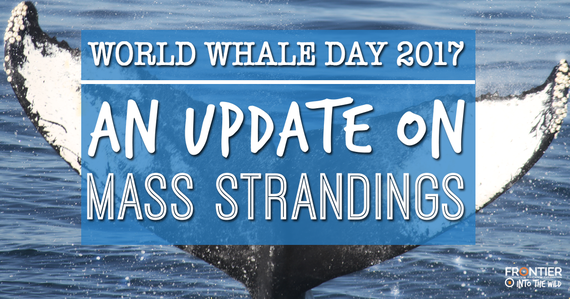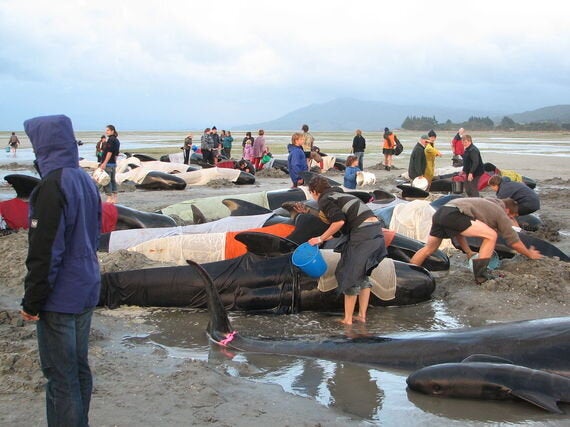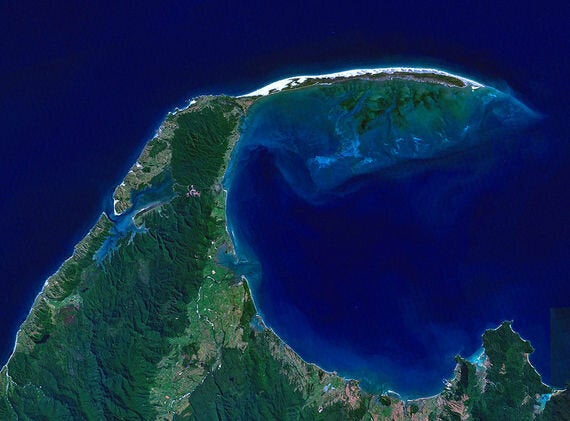
In recognition of world whale day tomorrow this article covers one of the stranger and sadder phenomenon in the cetacean world.
Last Thursday, February 9th, conservationists spotted the beginnings of a mass beaching event in New Zealand and by morning saw over 400 Pilot Whales left stranded along the shore of Golden Bay's Farewell Spit.
This spurred a huge volunteer effort, with hundreds of people turning up to calm and re-float the whales. Unfortunately around 300 of them had already died but the remaining 100 or so were successfully put out to sea. However conservationists feared that some of those rescued at high tide would stick to the shallows in an attempt to reconnect with their pod, or simply be washed up again.
This fear became a reality when 20 of them washed back up. The remainder did manage to join another large pod but also beached later that evening. Volunteers waded out to neck-deep water, forming a human chain to steer more whales away but still couldn't stop some coming through. Over the course of 2 days the total whale count was around 600.

Wikimedia Commons | Chagai at English Wikipedia [Public domain]
This isn't uncommon either; there have been several mass beachings over the past few decades. New Zealand has the highest number of whale strandings in the world, with this instance being the largest since 1985 and the country's third largest in history.
But why do they do it?
Several species of whale undergo an annual migration as their cold-water feeding grounds grow colder and food becomes scarcer, making them move off to warmer pastures. The warmer water also makes for perfect breeding sites. It is during these migrations when they are most vulnerable, as some routes are tricky to navigate and whales can get lost along the way, sometimes dying at sea and washing ashore. Calves can also become separated from their pods on the return trip, becoming lost and malnourished. However, to have 600 individuals stranded in such a short time suggests something else at play.
There are several theories as to why whales become beached in such numbers, with some suggesting interference from the Earth's magnetic field. Other speculations lean more toward disorientation via noise disturbance from human, naval and military activity and confusion caused by topography in shallow waters making it difficult to navigate by sonar. Once a whale knows it's lost and confused it sends out distress calls calling the aid of other members of the pod, sealing themselves to the same fate in the process. It's these topographical "whale traps" that manage to aggregate entire pods.
Pilot Whales are especially susceptible to mass beachings because of their social behaviour. As the name suggests, Pilot Whale pods are led by one matriarchal pilot; guiding the pod through their migrations. The Golden Bay, and its notorious Farwell Spit, is indeed a whale trap and when combined with the social nature of these whales had created a recipe for disaster. The precise cause of what drove them inland is still unknown.

Wikimedia Commons | [public domain]
Efforts to clear the carcasses are currently underway and, as deceased whales have a tendency to explode due to the build-up of gas in their bodies, the beach has been closed off to the public while they are dealt with. A watchful eye is also being kept on the sea to act as quickly as possible should more whales come in close.
More research is needed to understand and perhaps prevent these events, but until then the compassion of conservationists and volunteers will continue to mitigate losses.
By Thomas Phillips - Online Journalism Intern
Frontier runs conservation, development, teaching and adventure travel projects in over 50 countries worldwide - so join us and explore the world!
